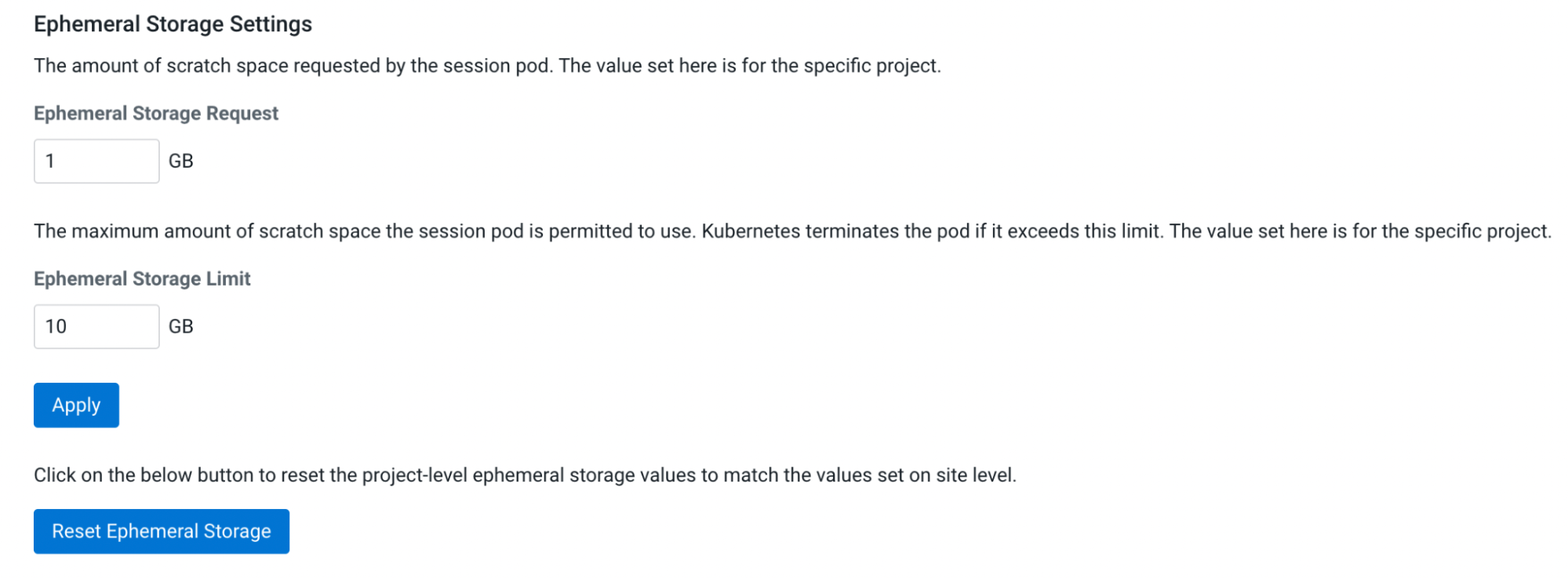Ephemeral storage
Ephemeral storage space is scratch space that a Cloudera AI session, job, application or model can use. This feature helps in better scheduling of Cloudera AI pods, and provides a safety valve to ensure runaway computations do not consume all available scratch space on the node.
By default, each user pod in Cloudera AI is allocated 0 GB of scratch space, and it is allowed to use up to 10 GB. These settings can be applied to an entire site, or on a per-project basis.
How Spark uses ephemeral storage in Cloudera AI
Spark drivers and executors write shuffle files, spilled RDD/DataFrame blocks, broadcast
variables, and task logs under directories referenced by SPARK_LOCAL_DIRS.
On Kubernetes these paths are mounted as one emptyDir volume per pod;
emptyDir is wiped as soon as the pod terminates, so the data is ephemeral.
kubelet evicts the pod and Spark surfaces errors
such as:- java.io.IOException: No space left on device
- org.apache.spark.shuffle.MetadataFetchFailedException
This is followed by a Kubernetes event similar to Evicted: The node was low on resource: ephemeral‑storage.
How does the CML UI map to Kubernetes resources
| CML field | Pod spec element | What it does |
|---|---|---|
| Ephemeral Storage (GB) – Request | resources.requests.ephemeral-storage |
Scheduler bin‑packing & cluster‑autoscaler logic |
| Ephemeral Storage (GB) – Max | resources.limits.ephemeral-storage |
Hard ceiling; usage ≥ limit → pod eviction |
Sizing guidelines for common Spark workloads
| Work‑load pattern | Rule of thumb (across all executors) | Rationale |
|---|---|---|
| SQL/ETL with light aggregations | ≈ 1 × largest input size | Minimal shuffle spill |
| Joins, `groupByKey`, heavy shuffle | 2 – 3 × largest input size | Shuffle writes often exceed input volume |
ML pipelines with .cache() / .persist() |
Cached dataset size × #replicas | Cached blocks are duplicated |
Tips to reduce Spark’s scratch‑disk footprint
| Goal | Knob | Notes |
|---|---|---|
| Fewer shuffle bytes | spark.sql.shuffle.partitions (closer to number of executors) and
spark.sql.adaptive.enabled=true |
Adaptive Query Execution coalesces partitions on the fly |
| Eliminate shuffle joins | Broadcast the small side: '/*+ BROADCAST(t) */' |
Keeps data in RAM when feasible |
| Compress spill data | Ensure spark.shuffle.compress=true (default) |
Small CPU cost, large disk savings |
| Use RAM‑backed volumes (SSD‑less nodes) | spark.kubernetes.local.dirs.tmpfs=true and raise
spark.kubernetes.{driver,executor}.memoryOverheadFactor |
Mounts emptyDir as tmpfs |
| Persist scratch across pod restarts | Mount a PVC at /spark-local with
spark.kubernetes.executor.volumes.persistentVolumeClaim.<name>.mount.path |
Gives Spark a dedicated disk |
Change site-wide ephemeral storage configuration
In , you can see the fields to change the ephemeral storage request (minimum) and maximum limit.

Override Site-wide ephemeral storage configuration
If you want to customize the ephemeral storage settings, you can do so on a per-project basis. Open your project, then click on and adjust the ephemeral storage parameters.

AWS Known Issues
There is a known issue with the cluster autoscaler that affects autoscaling from 0->1 if a non-zero value for Ephemeral Storage Request is set. This affects both CPU and GPU node groups of the Cloudera AI Workbench. The autoscaler throws the following error when this happens:
pod didn't trigger scale-up: 1 Insufficient ephemeral-storageThis is occurring even though the nodes in the Cloudera AI autoscaling groups have sufficient ephemeral storage space in their group templates. See this github issue for details. Even though the issue is closed, the problem still persists.
The issue only affects node groups that have [0, x] autoscaling range.
Set the Ephemeral Storage Request value to 0 in both the site-wide and project settings if you run into this issue.
